Sages/Salvias
 Looking for Sage Advice? Look No Further!
Looking for Sage Advice? Look No Further!
At SummerWinds Nursery, we have a wide variety of sage plants, from edible to ornamental.
Curious as to the difference between sage and salvia? To put it simply, all sages are salvia but not all salvias are sages. Salvia is a genus of plants that includes sages, mints, many species of shrubs, some perennials and annuals.
Sage plants range from perennial to annual. Some bloom, while others do not. Most sage plants are pretty hardy. Below are some of our favorites.
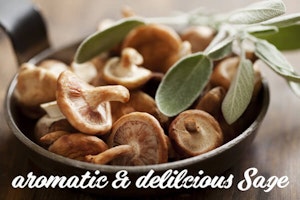 Culinary Sages
Culinary Sages
Garden Sage or Common Sage (Salvia officinalis)
Salvia officinalis is a culinary herb with leaves that can be used fresh or dried, in cooking or in teas. In some varieties, the blooms can also be used as garnishes. Beneficial insects are often attracted to those varieties that bloom. While these sages are perennials, we recommend that you consider replacing them every few years in order to retain the most robust flavor for your culinary needs.
These varieties generally grow up to 2-3 feet tall (with the exception of the dwarf variety), enjoy full sun and low water use.
Common or Garden Sage is Available in a Number of Varieties, Including:
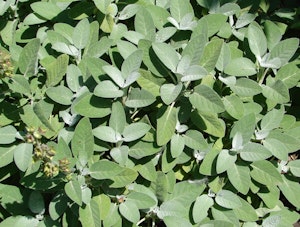 Berggarten Sage (Salvia officinalis 'Berggarten') - which means mountain sage. This variety rarely blooms and begins the season with new bright green leaves that mature to soft downy gray-green leaves, and a purplish cast when grown in full sun. The large oval leaves are a chef's favorite and provide excellent flavor. This plant performs best when it is trimmed often and not allowed to become too tall or woody.
Berggarten Sage (Salvia officinalis 'Berggarten') - which means mountain sage. This variety rarely blooms and begins the season with new bright green leaves that mature to soft downy gray-green leaves, and a purplish cast when grown in full sun. The large oval leaves are a chef's favorite and provide excellent flavor. This plant performs best when it is trimmed often and not allowed to become too tall or woody.
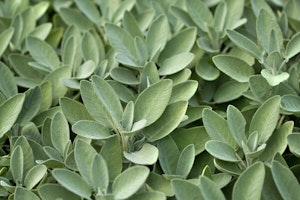 Garden Sage (Salvia officinalis) - This variety blooms pale green to pale purple egg-shaped blossoms for a few weeks in early spring. It's blooms can be sued as a garnish or in fresh bouquets.
Garden Sage (Salvia officinalis) - This variety blooms pale green to pale purple egg-shaped blossoms for a few weeks in early spring. It's blooms can be sued as a garnish or in fresh bouquets.- Dwarf Garden Sage (Salvia officinalis 'Minimum') - This is a petite version of regular Garden Sage (see the next listing) and boasts the same robust flavor in a smaller plant. Has purplish-blue flowers in early spring which can be used as a garnish or in sautéed dishes. Grows up to 1 foot tall.
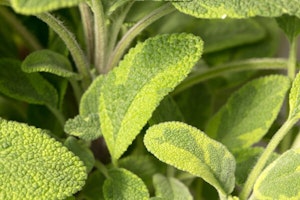 Golden Garden Sage (Salvia officinalis 'Icternia') - This variety boasts oval light green leaves with a darker-green leaf-shaped center. While it is very rare for this variety to bloom, when it does the blooms are blue.
Golden Garden Sage (Salvia officinalis 'Icternia') - This variety boasts oval light green leaves with a darker-green leaf-shaped center. While it is very rare for this variety to bloom, when it does the blooms are blue.
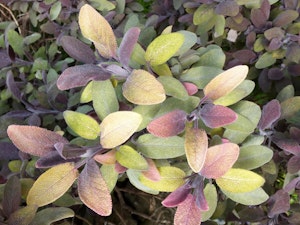 Purple Garden Sage (Salvia officinalis 'Purpurea') - This variety rarely reveals its blue blooms. Its green and purple leaves can be used in cooking or in teas.
Purple Garden Sage (Salvia officinalis 'Purpurea') - This variety rarely reveals its blue blooms. Its green and purple leaves can be used in cooking or in teas.
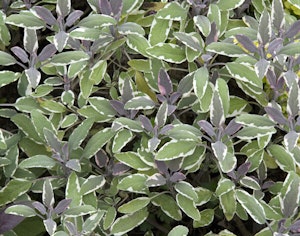 Tricolor Garden Sage (Salvia officinalis 'Tricolor') - The irregular variegation pattern found on its leaves are often used as a garnish on holiday poultry dishes. The leaves range in color from light pink and green to dark green and purple, often with at least three shades of color showing on the plant. This variety will occasionally bloom a purple flower spike. In order to bring out the most color in this variety, we recommend planting it someplace that gets afternoon sun; this will keep the leaves from getting sunburned. In addition, although this variety can grow with little water, we recommend providing it with extra water in the heat of summer for it to grow best.
Tricolor Garden Sage (Salvia officinalis 'Tricolor') - The irregular variegation pattern found on its leaves are often used as a garnish on holiday poultry dishes. The leaves range in color from light pink and green to dark green and purple, often with at least three shades of color showing on the plant. This variety will occasionally bloom a purple flower spike. In order to bring out the most color in this variety, we recommend planting it someplace that gets afternoon sun; this will keep the leaves from getting sunburned. In addition, although this variety can grow with little water, we recommend providing it with extra water in the heat of summer for it to grow best.
Four Other Culinary Varieties Are:
- Grape Scented Sage (Salvia melissordora) - This sage variety can grow up to 8 feet tall in full sun and with low water use. Both the leaves and flowers are fragrant and can be used to make tea. The flowers can be used as a garnish and attracts hummingbirds.
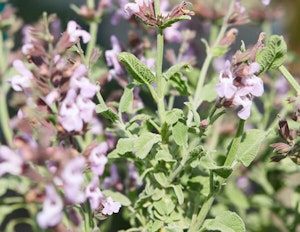 Greek Sage (Salvia fruticosa) - This variety can grow up to 4 feet tall (when it is in bloom) in full sun and with low water use. Strong camphor over-tones can be found within its unique flavor structure. This variety can ensure hot, dry climates with the assistance of its hairy leaves. Its blooms have peachy-apricot tones that bloom to white flowers with light lavender interiors. It is used to make Faskomilo tea.
Greek Sage (Salvia fruticosa) - This variety can grow up to 4 feet tall (when it is in bloom) in full sun and with low water use. Strong camphor over-tones can be found within its unique flavor structure. This variety can ensure hot, dry climates with the assistance of its hairy leaves. Its blooms have peachy-apricot tones that bloom to white flowers with light lavender interiors. It is used to make Faskomilo tea.
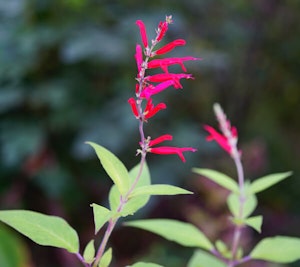 Pineapple Sage (Salvia elegans) - The late season blooming bright red tubular flowers are a favorite among hummingbirds and ladybugs! In terms of culinary use, its fresh flowers are edible and taste similar to a honeysuckle. They make a wonderful garnish or addition to summer salads and baked goods (when sugared). This variety can grow up to 3 feet tall within the valley and enjoys full/partial sun.
Pineapple Sage (Salvia elegans) - The late season blooming bright red tubular flowers are a favorite among hummingbirds and ladybugs! In terms of culinary use, its fresh flowers are edible and taste similar to a honeysuckle. They make a wonderful garnish or addition to summer salads and baked goods (when sugared). This variety can grow up to 3 feet tall within the valley and enjoys full/partial sun.
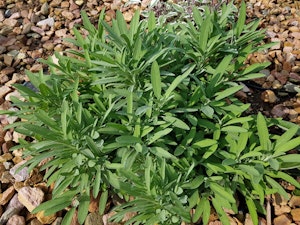 Spanish Sage (Salvia officinalis ssp. lavandulifolia) - This variety has none of the camphor flavor found in other varieties. It is excellent for making tea and can be used in place of garden sage in any recipe. It grows up to 2 feet tall in full sun and with low water use. It occasionally blooms purple flowers on spikes.
Spanish Sage (Salvia officinalis ssp. lavandulifolia) - This variety has none of the camphor flavor found in other varieties. It is excellent for making tea and can be used in place of garden sage in any recipe. It grows up to 2 feet tall in full sun and with low water use. It occasionally blooms purple flowers on spikes.
Ornamental Sage Plants
Cimarron® Texas Ranger (Leucophyllum zygophyllum 'Cimarron')
This sage is smaller growing and more dense than most Texas Sage varieties (see below). This tough, rounded shrub is compact and grows to about 3 feet tall and wide. This gray-green leafed evergreen blooms blue, showy flowers profusely and often in the spring and fall. Prefers full sun and occasional watering, once established.
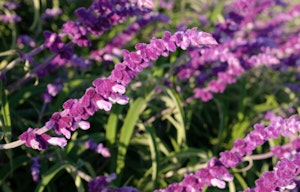 Mexican Bush Sage (Salvia leucantha)
Mexican Bush Sage (Salvia leucantha)
The Mexican sage is drought-tolerant and attracts butterflies and hummingbirds. This hardy shrub can grow 3 to 4 feet tall and wide and tolerates full sun, partial shade and low water use. It produces white or purple blooms summer through late fall.
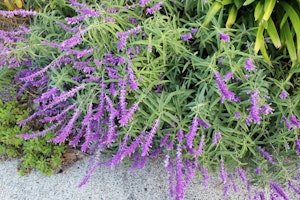 Russian Sage (Perovskia atriplicifolia)
Russian Sage (Perovskia atriplicifolia)
This perennial plant produces blue-violet blooms mid-summer to late fall. It has an upright habit with grey-green leaves and can grow 1.5 to 4 feet tall.
Blue Spires Russian Sage (Perovskia atriplicifolia 'Blue Spires') - This is a particularly popular variety of Russian Sage and boasts dark blue flowers over many months. It can grow up to 4 feet tall and wide and is good for firescaping.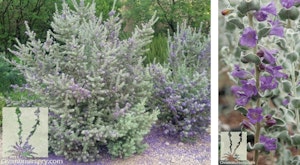 Sierra Bouquet™ Sage (Leucophyllum pruinosa 'Sierra Bouquet')
Sierra Bouquet™ Sage (Leucophyllum pruinosa 'Sierra Bouquet')
This grape bubble gum scented varitey has silver-gray foliage and blooms blue-violet flowers summer through fall. Enjoys full sun, low water use and well-drained soils. Grows 6-8 feet tall and wide.
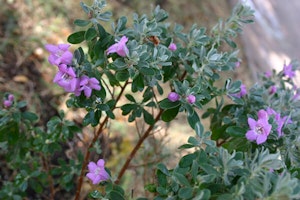 Texas Sage (Leucophyllum frutescens)
Texas Sage (Leucophyllum frutescens)
The Texas Sage bush is a medium sized shrub that is also available in compact varieties. It has soft silver to gray foliage with beautiful lavender-purple blooms summer to fall. Texas Sage enjoys full sun (at least 8 hours) and well-draining soil. Once established, it is drought, heat tolerant, disease tolerant, and it's easy to care for.
Texas Sage comes in a number of varieties, including:
- Compact Texas Sage (Leucophyllum frutescens 'Compact') - This evergreen shrub has silver-gray foliage with magenta to lavender blooms mid-spring through fall. It is compact and grows 3 feet tall and wide.
- Green Cloud Texas Sage (Leucophyllum frutescens 'Green Cloud') - Texas Sage 'Green Cloud' is a valley favorite. This variety blooms more often than other varieties. It can grow up to 6 feet tall and wide, enjoys full sun and is drought resistant. Dark green foliage is topped by rose-magenta colored blooms.
- Heavenly Cloud Texas Sage (Leucophyllum frutescens 'Heavenly Cloud') - This variety has a dense habit and grows more slowly than other varieties. It generally grows 6-8 feet tall and wide. Deep purple blooms appear early summer through fall atop gray foliage.
- Rio Bravo Texas Sage (Leucophyllum frutescens 'Rio Bravo') - This variety has a rounded habitat and can grow up to 7 feet tall and wide. It boasts purple, lavender and occasionally white blooms summer through fall atop small gray leaves.
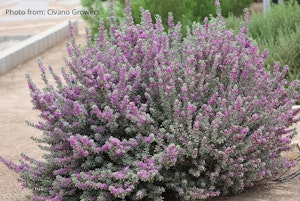 NEW AT SUMMERWINDS: San Antonio Rose Texas Sage (Leucophyllum frutescens 'San Antonio Rose') - A tighter growth habit than the Compact variety, with substantially larger bright rose pink flowers that bloom continusoulsy through summer—especially with the humidity the Valley gets during Monsoon season.
NEW AT SUMMERWINDS: San Antonio Rose Texas Sage (Leucophyllum frutescens 'San Antonio Rose') - A tighter growth habit than the Compact variety, with substantially larger bright rose pink flowers that bloom continusoulsy through summer—especially with the humidity the Valley gets during Monsoon season.
To learn more about which sage plant may be perfect for your garden, speak with one of our Trusted Garden Advisors.

